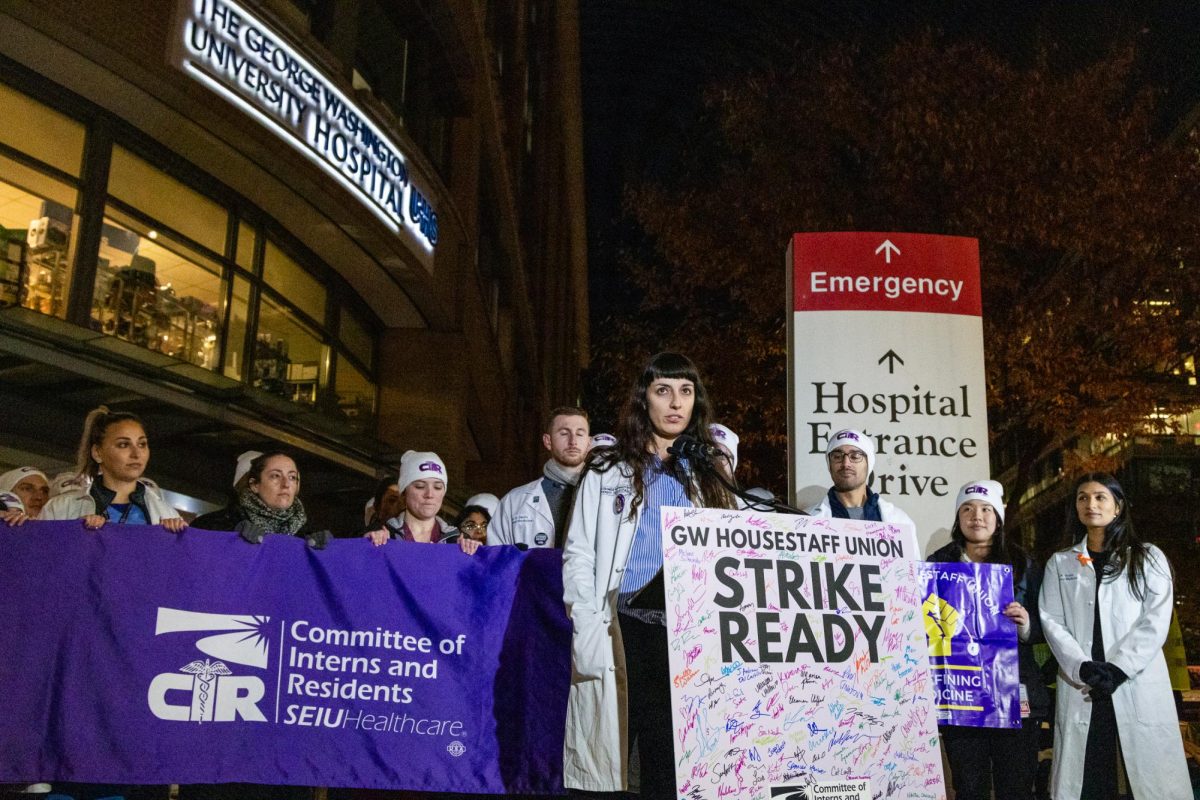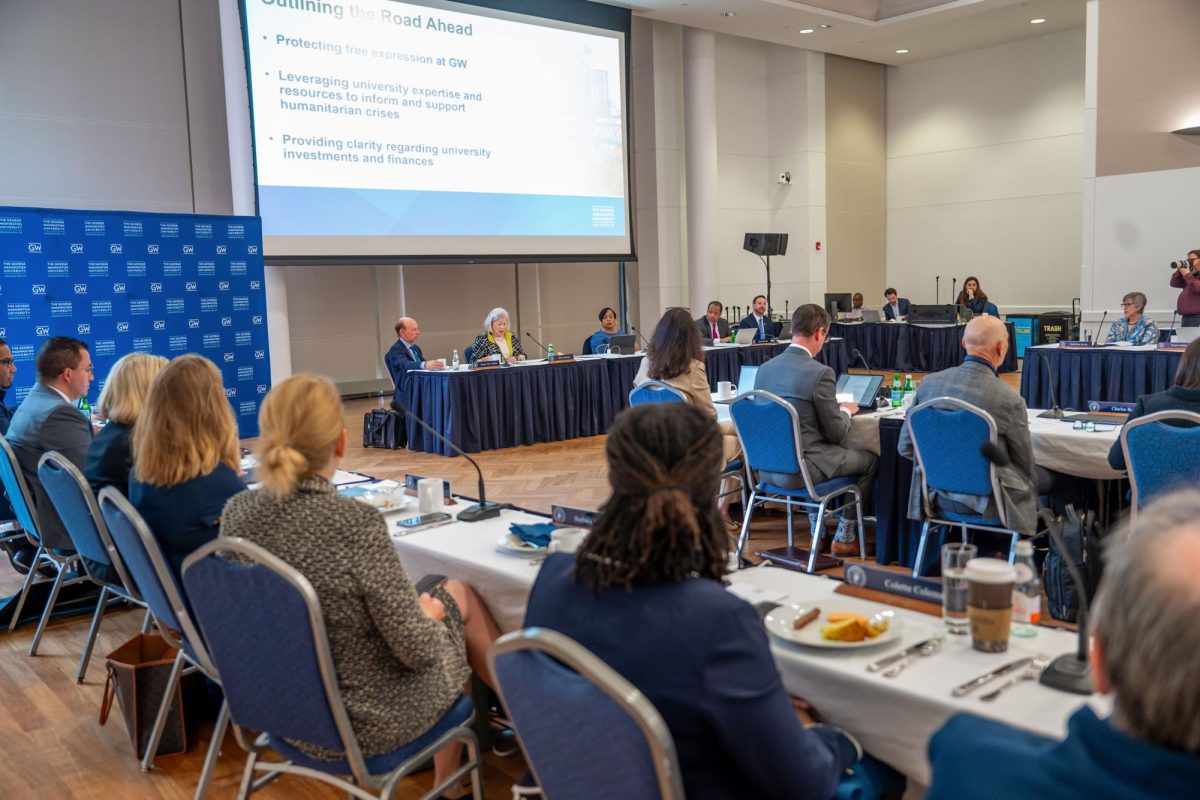Updated: March 1, 2020 at 12:57 p.m.
The Faculty Assembly unanimously approved the Faculty Senate’s actions over the past semester to collect information undergirding the 20/30 Plan Tuesday.
Sylvia Marotta-Walters, the chair of the senate’s executive committee, called a special meeting of the assembly after dozens of faculty signed a petition earlier this academic year asking the Faculty Senate to investigate details surrounding the University’s strategic planning process. Faculty heard updates from Provost Brian Blake about the Future Enrollment Task Force he organized and heard from the chairs of the senate’s committees on each committee’s work to meet the assembly’s request.
“We don’t have a long history at GW of doing special assemblies, and so we’re in some ways carving new ground here,” Marotta-Walters said.
The Faculty Senate passed several resolutions last December in response to a Faculty Assembly petition calling for more information supporting the numbers underlying 20/30 Plan, a 20 percent cut in undergraduate enrollment and a 30 percent increase in the ratio of STEM students. The resolutions passed by the Faculty Senate in December included scheduling the special meeting of the Faculty Assembly and requesting updates from the four strategic planning committees.
University President Thomas LeBlanc joined the provost, Marotta-Walters and the leaders of each senate committee in attending the assembly meeting.
Blake, the provost, said he convened the enrollment task force because he thought it would be “appropriate” to form a representative group of administrators, faculty and students to review the numbers behind the strategic plan. He said he has worked closely with Gayle Wald, the chair of the strategic committee for undergraduate education, to create a “broader focus” on future enrollment at GW.
Blake said the committee, composed of deans from four schools, three faculty members, a student and a staff member, has met about a half-dozen times since its formation.
“That committee is really looking at mechanizing the strategy,” he said. “I have not forced them to think about the numbers, finances or about the 30 percent.”
Blake informed faculty present that the task force’s discussions have focused on improving the academic experience for students five to 10 years from now based around six or seven themes or main priorities that he did not specify.
Harald Griesshammer, an associate professor of physics, said the data received by faculty until now show that the University will lose millions of dollars and shrink its population of underrepresented minorities under the plan, which “contradicts” the “underlying assumptions” of the plan.
“So in the face of data, do we not just have the right, but the duty, to act rationally and stop this plan?” Griesshammer said. “This is not the time for full speed ahead.”
Six models mapping the potential effects of the enrollment cut predicted an $8 million to $36 million annual revenue loss, according to former Provost Forrest Maltzman’s presentation to a Faculty Senate committee last October. The models also predict a 2 to 7 percent decline in minority enrollment relative to the baseline, but LeBlanc has said those models do not reflect the most recent planning around the University’s finances and diversity levels.
Blake said officials have two options: keep GW at its current level or enact the 20/30 Plan, which he said will allow administrators to be more generous in offering financial support to students in the future. He said there are other ways for GW to absorb the costs of the strategic plan than reducing spending, like making off-campus investments.
Sarah Wagner, a faculty senator and the chair of the special committee created by the senate to respond to the petition, gave a report on each of the six items listed in the petition based on the senate’s investigations after Blake’s presentation and presentations from each of the senate committee chairs.
Griesshammer, the associate physics professor, proposed a motion at the assembly to support the actions taken by the Faculty Senate’s committees to gather more information to support the premises of the 20/30 Plan.
Guillermo Orti, the president of the Faculty Association and a professor of biology, said he supported Griesshammer’s motion in part because faculty have not received information about the costs of GW’s partnership with the Disney Institute in service of improving the University’s institutional culture.
Officials first partnered with the Disney Institute in 2018 to assess the GW’s culture through faculty and staff surveys and focus-group interviews, informing four areas of improvement like leadership accountability and employee appreciation. LeBlanc said the institute’s initial consulting services cost about $300,000, but officials have declined to comment about the entire cost of the partnership.
Administrators announced last February that they planned to extend GW’s partnership with the Disney Institute for another two years. Mark Diaz, the executive vice president and chief financial officer, said last week that about 500 University leaders will participate in a Disney-led 10-month leadership program covering topics like trust-building and active listening.
“In my opinion, this top-down initiative designed by the Disney Institute is the opposite of what this University needs,” Orti said.
Bernard Wood, a University professor of human origins, said LeBlanc has not shown enough respect for the faculty’s role in the University’s decision-making processes by excluding them from the planning process.
Each of the four committees created to gather recommendations for the University’s next strategic plan consists of and is led by faculty, but professors have criticized the fact that the committees are constrained by – and unable to question the merits of – the 20/30 Plan.
“The fact that you have not involved us in this decision, the fact that you’ve been rather opaque about some of those decisions, that shows a lack of respect to us,” Wood said. “And I resent that.”
After debate closed, the assembly approved Griesshammer’s motion by a vote of 189 to 0.
This post has been updated to reflect the following:
An earlier version of this post stated that Griesshammer called on Blake to provide more information about the 20/30 Plan. He said at the meeting that the data presented do not support the plan. That language has been clarified.





